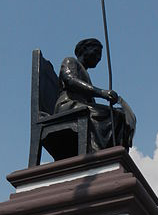|
Kapampangan People
The Kapampangan people ( pam, Taung Kapampangan), Pampangueños or Pampangos, are the sixth largest ethnolinguistic group in the Philippines, numbering about 2,784,526 in 2010. They live mainly in the provinces of Pampanga, Bataan and Tarlac, as well as Bulacan, Nueva Ecija and Zambales. Overview The province of Pampanga is the traditional homeland of the Kapampangans. Once occupying a vast stretch of land that extended from Tondo to the rest of Central Luzon, huge chunks of territories were carved out of Pampanga so as to create the provinces of Bulacan, Bataan, Nueva Ecija, Aurora and Tarlac.Henson, Mariano A. 1965. ''The Province of Pampanga and Its Towns: A.D. 1300–1965''. 4th ed. revised. Angeles City: By the author. As a result, Kapampangans now populate a region that extends beyond the political boundaries of the small province of Pampanga. In the province of Tarlac, the indigenous population of Tarlac City and the municipalities of Bamban, Capas and Concepcion are ... [...More Info...] [...Related Items...] OR: [Wikipedia] [Google] [Baidu] |
Central Luzon
Central Luzon ( pam, (Reyun ning) Kalibudtarang Luzon, pag, (Rehiyon na) Pegley na Luzon, tgl, (Rehiyon ng) Gitnang Luzon, ilo, (Rehion/Deppaar ti) Tengnga ti Luzon), designated as Region III, is an administrative region in the Philippines, primarily serving to organize the 7 provinces of the vast central plains of the island of Luzon (the largest island), for administrative convenience. The region contains the largest plain in the country and produces most of the country's rice supply, earning itself the nickname "Rice Granary of the Philippines". Its provinces are: Aurora, Bataan, Bulacan, Nueva Ecija, Pampanga, Tarlac and Zambales. Pangasinan was formerly a province of Central Luzon before President Marcos signed ''Presidential Decree No. 1'', 1972, incorporating it into Ilocos Region. Additionally, the province of Aurora was part of the defunct political region Southern Tagalog when the region was divided into Calabarzon and Mimaropa, upon the issuance of ''Executive Ord ... [...More Info...] [...Related Items...] OR: [Wikipedia] [Google] [Baidu] |
Ethnic Groups In The Philippines
The Philippines is inhabited by more than 182 ethnolinguistic groups, many of which are classified as "Indigenous Peoples" under the country's Indigenous Peoples' Rights Act of 1997. Traditionally-Muslim peoples from the southernmost island group of Mindanao are usually categorized together as Moro peoples, whether they are classified as Indigenous peoples or not. About 142 are classified as non-Muslim Indigenous People groups, and about 19 ethnolinguistic groups are classified as neither indigenous nor moro. Various migrant groups have also had a significant presence throughout the country's history. The Muslim-majority ethnic groups ethnolinguistic groups of Mindanao, Sulu, and Palawan are collectively referred to as the Moro people, a broad category which includes some indigenous people groups and some non-indigenous people groups. With a population of over 5 million people, they comprise about 5% of the country's total population, or 5 million people. The Spanish called ... [...More Info...] [...Related Items...] OR: [Wikipedia] [Google] [Baidu] |

